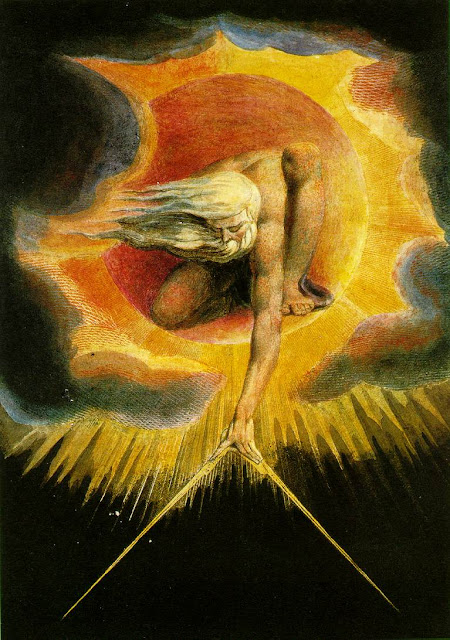Wilhelm Uhde: art dealer, connoisseur, said about French landscape painting, “The great quality of the earth is life, and its fountainhead is the sun. But the great quality of life is art, and its fountainhead is the human heart - what Jean Paul calls the “refraction of the sun". This refraction of the sun, the loving heart, - therein lies the entire history of French painting.”
Uhde goes on to talk about Poussin as being the source of two great strains; one rich and powerful, based on noble and lasting material, and the other more delicate and thinner. He describes this strain as the one “on which floats the mere reflection of things like colored shadows, flowered shawls and rare stuffs - is it not called at its source Watteau or Claude Lorrain, or Delacroix and finally, Renoir and Bonnard?"
 |
| "A Wooded Landscape with Distant Buildings,” 1640–50, by Claude Lorrain. Black chalk, brown wash, black chalk framing lines, 8 by 11 inches. Sterling and Francine Clark Art Institute, Williamstown, Mass. |
John Constable described Claude as "the most perfect landscape painter the world ever saw", and declared that in Claude’s landscape "all is lovely – all amiable – all is amenity and repose; the calm sunshine of the heart".
I have always loved Claude Lorrain's landscape and even though he was a Pre Romantic painter his real interest lay in the scenic landscapes. He was at the core a romantic. His need to include gods and demigods in his paintings following the classical order of things was more one imagines the pressures of commerce.His real heart lay in his sketchbooks that followed nature far more closely. Lyrical trees perfectly composed in uninhabited landscapes, He was laying down images that the Romantics like Constable would hold in high esteem.
 |
| John Constable, "The Cornfield", painted 1826. Size: 56 by 48 inches (143 by 122 cm). National Gallery, London (UK). |
Now you may ask why I am carrying on about Claude Lorrain and The Romantics, it is because this particular commission was motivated and inspired by both Lorrain and the rich traditions of Romantic art and poetry. It was this love of landscape painters, Poussin, Lorrain, Constable the poetry of the Romantics, the promise of the PreRaphaelites that somewhere in between the lines of their individual vernacular, I found mine.
Commissioned by Joanna Poiter of JSP interiors, Los Angeles, this kitchen was a labor of love, that refraction of the sun.


The space itself was octagonal, and quite a challenge, with several openings and narrow panels that I had to stitch together as a panorama. Let alone, having to paint over a pre-finished counter that was one solid block of marble that I obviously did not want to damage.
To top it all, there we were, right in the thick of it - a running household with a running kitchen, and we were painting every square inch! It soon became an exercise in precision, with a tight deadline of six weeks. On a project such as this, and where a family spends so much time, it was imperative that it fit our client perfectly.
Sometimes in life we are all handed gifts - this kitchen, the client, the atmosphere were all coalescing together to create that perfect experience that we all crave. That coming together of ideas and influences. That romantic ideal of arriving at an aesthetic that was propelled by emotion, with nature as its muse.

As Constable put it, "the calm sunshine of the heart". Here was a woman who loved a sense of light - it is to her essential for her well being. It was imperative that I didn't go too dark. So I created for myself a strict palette of analogous colors, determined to maintain, within an intricate space, with intricate details, a sense of order. What I loved the most about working there was that every Friday the house would be filled with flowers. It was a ritual that I looked forward to, and in that array I would also find my palette as well as my subjects.
It was a running joke that the holes in the arrangements was me running off with my references of the day! And those full bodied yellow roses and the stony pink cabbage roses would find there way into my painting bucket, happily mixed in with a slew of brushes. I had previously worked with limited palettes, but had never quite been as rigid as I was here. The discipline, I am convinced, helped me create a sense of overall tranquility. I started with a set of drawings, based on elevations of the space. I created a foreground with a lattice on top and a fence at the bottom. These were my unifying elements. The aim was to make sense of the various openings by making them a part of the overall design.
Using Wisteria and roses in the foreground, and thin glazes in varying shades of brown, rose, and beige, I attempted to give the background a wispy imaginative quality. I wanted it to feel like the evening sun in some places, with lengthening shadows, and in other places make it feel as we walked out into a misty spring shower. I wanted to capture the mere reflections of things, of flowered shawls and long evening walks, the pure romantic ideal of nature. I do ask myself as to why I am compelled to quote both Constable and Uhde. It could be that I believe them both to be brilliant commentators on the nature of things, but it is more because they both describe a sense of light and joy and an intangible expression of the human soul through landscape paintings. It is this sense of peace wonderment and disappearing barriers is what I wanted to capture and, one hopes, I was successful.


















